The Shoulder Insignia of Council 392
The Shoulder Insignia of Council 392
Update: Jamboree Neckerchiefs and Certificates of Authenticity
Update 2: Rare Finds and a New Mystery
Last year, we celebrated the 25th anniversary of the demise of BSA Council 392, then known as the Hudson-Delaware Council, with a look back at the history of the insignia of its Order of the Arrow Lodge, Skanondo 64. This year marks the 100th anniversary of the birth of BSA Council 392, then known as the Orange County Council (one of many). So now we’re going to explore the history of the council’s insignia, absent the more rare and valuable pieces.
After Scouting was introduced to the US in 1910, organizational structures were a bit fluid. Many areas had no organization beyond the community level while others formed informal or formal councils of various sizes. Councils were then known only by their name and location, which must have made things confusing when three Orange County Councils had been formed by 1922. Numbering would come later in the 1920s and wouldn’t be completely figured out until the 1960s. Somewhere in there, the council in question was designated Council 392. As with the origins of most things council-related, the details are sketchy
The Orange County Council would merge with the neighboring Sullivan County Council in 1931 to form the aptly-named Orange-Sullivan Council. Well, maybe not so aptly-named for the Scouts in Pike County, PA, which was part of the council for some reason. The merger made sense because all of the camps used by the Orange County council were in Sullivan County anyway. Though, by that point, many of the camps used by the Greater New York Councils were as well. Sullivan County was clearly the place to be for Scouting in the late ’20s and ’30s.
The final change happened in 1958, when the Orange-Sullivan Council renamed itself to the Hudson-Delaware Council after the two major rivers it spanned (or at least extended halfway into, as was the case for the Hudson). This iteration of the council would be last to bear the number 392, which was retired when the Hudson-Delaware Council ceased to exist after the calendar turned over to 1996 and the Hudson Valley Council was born.
Council Strips
The history of BSA shoulder insignia and its terminology are both far too complicated and convoluted to explain in their entirety here. In fact, “Council Strip” isn’t even an official term, not that there is a single official term. You will commonly see the terms Council Shoulder Patch (CSP), Jamboree Shoulder Patch (JSP), Shoulder Activity Patch (SAP), Red White Strip (RWS) and many others. They all refer to the patches worn at the top of the left shoulder on the uniform to designate where a Scout is from. CSP and SAP typically refer to the graphical patches issued starting in the 1970s, while RWS and other lettered strips refer to what came before. You can find some basic info in these articles at Boy Scout Collectibles and The Scout Patch Auction. Several of the printed references also provide sometimes conflicting historical details. I’m not getting into that can of worms, so good luck figuring things out.
As with lodge flaps, there have been many efforts to catalog all of the various issues of council strips. Most of them have been out of print for more than 20 years. The only one that isn’t is “An Aid to Collecting Council Shoulder Insignia with Valuation Guide” (hereafter referred to as the CSI Guide) by some combination of Austin, Ellis, Frank, Hook, Jones, and Keasey (depending on the year), which was in more-or-less annual publication from 1989 to at least 2014 (a 2017 edition is also available on the ISCA Members Only site, though that isn’t advertised anywhere). As with the OA Blue Book, publication is now handled by the ISCA. The 2009 edition is the only version I currently have for reference – this title has never been made publicly available electronically despite essentially being a very large spreadsheet.
The CSI Guide differs from the OA Blue Book in a few notable ways. While the leading letter distinguishes fully embroidered patches (S in both) from patches with bare twill (F in the OA Blue Book, T in the CSI Guide), the CSI Guide uses a single chronological numbering sequence regardless of designation. For example, a twill followed by a fully-embroidered patch would have the sequence T1 S1 in the OA Blue Book and T1 S2 in the CSI Guide. The CSI Guide also includes an A (for Activity, as in SAP) designation for patches that are restricted or limited issues, so if the second patch in the previous example was issued as a fundraiser, it would have the designation SA2. Finally, only CSPs and SAPs are listed in a council’s sequence, with all lettered strips listed together in another section and JSPs omitted entirely (because the original authors did not collect them). Nothing other than shoulder insignia is included, unlike the OA Blue Book, which covers other forms of insignia such as pocket patches and jacket patches.
The older reference book “A History of Council and Jamboree Insignia” by Albertus Hoogeveen, commonly referred to as Arapaho I, covers some of the gaps in the CSI Guide. Jamboree insignia, both the patches and neckerchiefs from the events and contingent insignia worn by councils, are covered as well as other forms of council insignia, referred to as “Council Patches.” Arapaho I also includes black and white photos of most of the covered items, making it a big help when identifying unusual items. Unfortunately, the most recent version of Arapaho I I have is from 1984, severely limiting its utility.
On the JSP side, the 1998 guide “BSA National Jamboree Shoulder Insignia: A History in Color,” which is available as a free download, picks things up where Arapaho I left off and continues through to the first National Jamboree attended by the Hudson Valley Council, with full-color photographs of a good number of patches. Unfortunately, it is far from complete – fully half of the Hudson-Delaware Council and Hudson Valley Council JSPs from the covered timeframe are not listed. New for 2023 is The JSP Guide by David T. Miura, available as a free download. It’s the first guide to list the 1993 National Jamboree Hudson-Delaware Council contingent issues, though it (in the first version, at least) still omits my troop’s patch. And it opened a can of worms.
Sadly, the available online references aren’t much better. Councilstrip.com uses the CSI Guide’s notation and features pictures of most listed issues. It also attempts to include variations not noted in the CSI Guide and includes many JSPs with the cumbersome NJXXXX (with the XXXX replaced with the year) notation. However, it features few of the notes found in the CSI guide, making it extremely difficult to distinguish between issues. It also generates pages using a script, making direct links to council pages impossible and preventing the Wayback Machine from archiving its contents, making everything inaccessible if the site goes down (as it did nearly a year ago, only returning just recently). Its last update was officially in 2017, but there is little, if any, new content past 2010.
The other main online guide is the ISCA’s The Council Guide, which attempts to fix some of the problems with previous guides. Listings are all renumbered in chronological order (or at least their best guess) with lettered strips and JSPs included (with no activity designation) and many additional variations are listed. Notes on distinguishing issues and variations are also included. Unfortunately, this guide is quite lacking in pictures and many issues were still left out prior to the renumbering, leaving them either unlisted or unnumbered. This guide also has little new content from after 2010, but the 2012 edition (minus pictures) is available for download in multiple parts. Council Patches are listed in a separate section, but the content appears to mostly have been pulled from Arapaho I.
With so much now under the ISCA’s umbrella, you would expect some updates to be forthcoming. Unfortunately, they are pretty bad at communicating their ongoing efforts to anyone who isn’t already a member (which I wasn’t until just recently because of that very fact). Looking at their web site, it would seem that the only perk of membership is access to their newsletter. In reality, they have a huge archive of reference material and are working toward updating all of their publications and keeping them current. To that end, they have a new edition of the CSI Guide in draft on the ISCA Members Only site and a separate lettered strip guide in work.
Things are looking up as of the middle of 2023, but it’s still a bit of a fragmented mess. If I want a complete reference for Hudson-Delaware Council insignia, I’m going to have to build it myself. So I did. I’m still missing several key items, but the available online references can fill most of the gaps. For now, this will just cover council insignia and related items. Camp issues and activity patches are much bigger projects that will have to wait for another day.
To allow for relative size comparisons between items of the same type, pins are displayed at 300dpi, neckerchiefs and jacket patches are displayed at 60dpi, and most other items are displayed at 100dpi. The resolution of each image is appended to the end of the filename for easy reference.
Orange-Sullivan Council: The Misspelling Adventure Begins
Orange-Sullivan Council 01 (CG T1) – Khaki and Red “ORANGE SULLIVAN” (1930s-1940s)
Orange-Sullivan Council 02 (CG T2) – Khaki and Red “ORANGE SULLIVAN CO.” (1930s-1940s)
Orange-Sullivan Council 03 (CG T3) – Red and White “ORANGE SULLIVAN COUNCIL” (1950s)
There aren’t many mentions of Orange-Sullivan Council insignia out there, so I’m going to have to go with what The Council Guide lists. They list these three patches, two with red stitching on khaki twill (KRS) and one with white stitching on red twill (RWS), all with slightly different lettering. And all missing the hyphen, making the council name misspelled in each and every one of them and beginning a trend that continues to this day (or at least NOAC 2022). These are the only items listed here that I haven’t seen a photograph of.
Orange-Sullivan Council Neckerchief – 1950 National Jamboree (1950)
Well, those and this. I had no idea it even existed until I found a copy of the Orange-Sullivan Council Troop 4 1950 National Jamboree Official Log randomly on eBay. Of course I bought it, scanned it, and posted it online for anyone to access for free. Reading it gives some valuable insight into the contingent’s trip to the second National Jamboree, but what stood out to me was this:
“And those Orange-Sullivan neckerchiefs that were passed out. They’ll sure to be red hot swap items.”
(A note of caution, don’t try to use OCR on that file. You won’t get anything resembling words out of it that way.)
Later on, the neckerchiefs show up again. Well, it’s more that they fall down:
“Just as we were sitting down to supper, Mr. Innocent flew over the camp and dropped a whole string of neckerchiefs.”
So while the Orange-Sullivan Council never issued any Jamboree Shoulder Patches (and even the Hudson-Delaware Council didn’t have any until 1981), neckerchiefs are a different story. No description was given, but Temple Hill was a recurring theme with the contingent – maybe that factored into the design? There are a lot of unknowns here when it comes to neckerchiefs. The National Jamboree Memorabilia Guidebook, 1995 Edition (free download) does not list any Orange-Sullivan or Hudson-Delaware neckerchiefs. I guess we’re on our own.
Hudson-Delaware Council Part 1: Red and Whites and Odds and Ends
Hudson-Delaware Council 01 (CG T1) – Red and White (Type 1 TLR) (1958-1972)
Hudson-Delaware Council 01 (CG T1) – Red and White (Type 1 TLM) (1958-1972)
Hudson-Delaware Council 01 (CG T1) – Red and White (Type 2 TLM) (1958-1972)
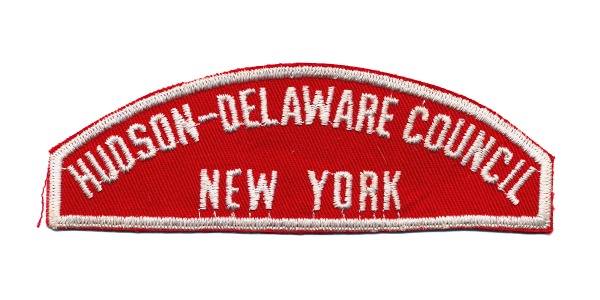
Renamed in 1958, the Hudson-Delaware Council first existed after the BSA had mostly standardized on red twill with white stitching for shoulder insignia. The 2017 edition of the CSI Guide lists three variations for this patch – a Type 1 border with rough left twill, a Type 1 border with medium left twill, and a Type 2 border with medium left twill. The Type 2 border version is shown above.
For a decade and a half, this was the only council insignia available. Not that it mattered to most people; outside of council officials and special events, nobody would have used this patch. Instead, Community Strips with state segments were the norm for the vast majority of Scouts in this era.
Bethlehem NY Community Strip – Red and White (1950s-1970s)
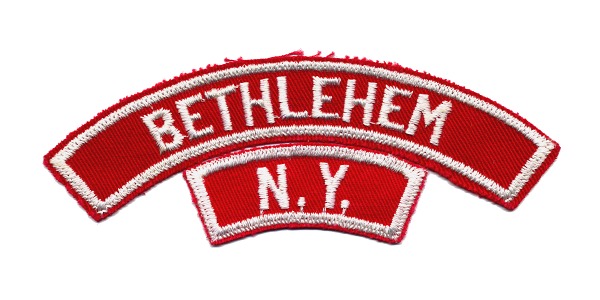
And here’s an example of what my troop might have worn if it had existed in that era. Or maybe it would have just been Cornwall.
Cornwall NY Community Strip – Red and White (1950s-1970s)
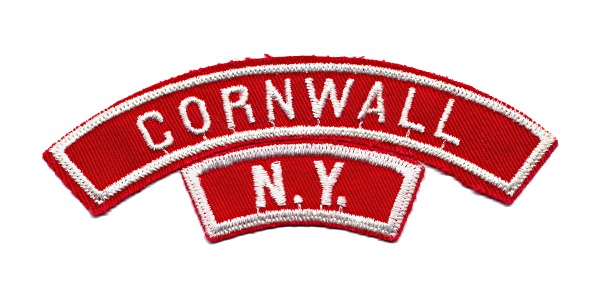
I really don’t know what counted as a “community” back then and the historical record is far from complete in this area. As mentioned in some of the references, Community Strips were made-to-order in small batches. Troops came and went, so usage was likely intermittent in less populated areas. Cornwall alone has 8 hamlets that could have counted as communities in addition to the town of Cornwall itself and the village of Cornwall-on-Hudson. Now multiply that by every town and city in a council. It’s amazing it took them nearly half a century to move to CSPs.
Cornwall-On-Hudson NY Community Strip – Red and White (1950s-1970s)
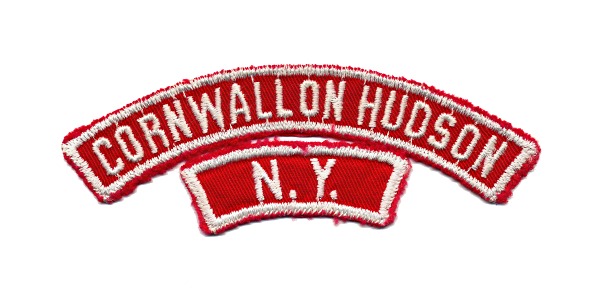
And here’s one for the other side of town.
Hudson-Delaware Council R1 – Overlapping Heads (1960s?)
We’ll see this logo later, but the first Council Patch issued by the Hudson-Delaware Council featured a red, white, and blue logo with overlapping heads of an Indian and a settler. This is a fairly standard 3″ round and likely dates to the 1960s. This is the only use of this logo I’ve seen prior to the 1990s.
Hudson-Delaware Council X1 – Triangular Logo Jacket Patch (1970s)
The next logo used by the council was this triangular logo with each of the three words in the name on a side of a triangle with the corners cut off. This logo was also used on activity patches dated 1970 and 1971 as well as a bolo tie (shown below) and a tie bar and cufflinks, among other things. This logo was also used by the Bronx Council for the 1968 Jamboree Scoutaree. I do not know which use came first.
Technically, this is a misspelling because the hyphen is omitted, not that there’s anywhere to put it. I’ll give them a pass on this one, just don’t let it happen again…
Hudson-Delaware Council Bolo Tie – Triangular Logo (1970s)
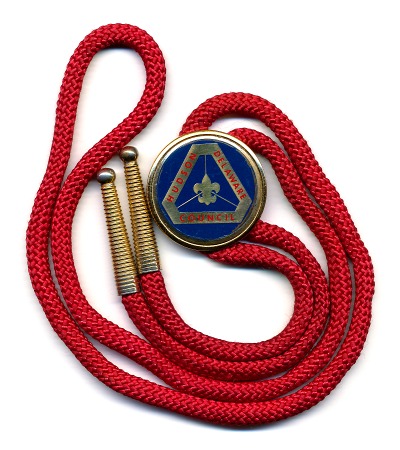
Hudson-Delaware Council R2 – 50th Anniversary 1922-1972 (1972)
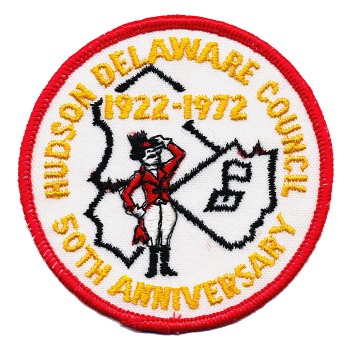
And here’s where things get complicated, and not because of the misspelling – the hyphen is clearly omitted, no excuses this time. Instead, we have a problem with the timeline. The Council Guide lists this patch as the R2, one ahead of the two rivers pocket patch below. But Arapaho I lists this as the 104 and the R3 as the 103. Except on the page with the photos, where the numbers are reversed. So which came first? I’ll leave it here for now because I have no idea. At least they got the dates right?
The patch itself is rather basic with a Scout Showman figure in front of a rough outline of the counties that make up the council. The council headquarters in Middletown is represented by a flag stuck in a square in the middle of Orange County. It looks like a concept sketch that was rushed into production without being finished.
Hudson-Delaware Council Part 2: Two Rivers, Three Trees
Hudson-Delaware Council 02 (T1/T2)- Regular Issue (CB TL) (1958-1972)
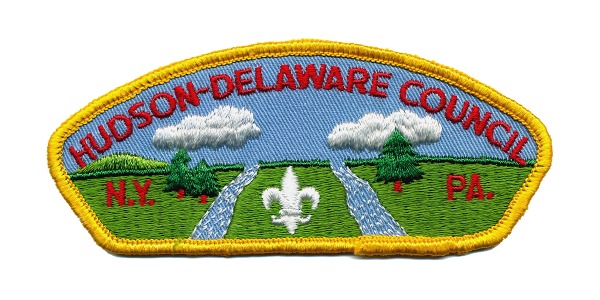
Hudson-Delaware Council 02 (T1/T2)- Regular Issue (CB TR) (1958-1972)
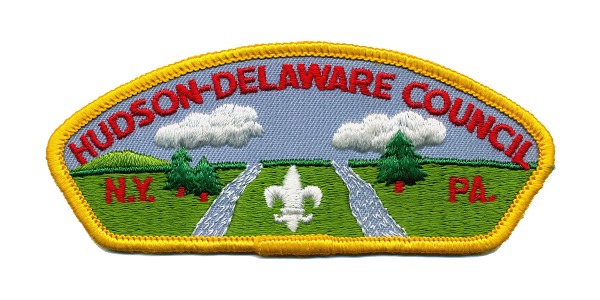
Hudson-Delaware Council 02 (T1/T2)- Regular Issue (PB TL) (1958-1972)
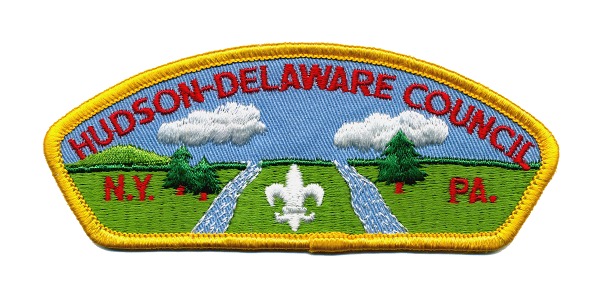
Hudson-Delaware Council 02 (T1/T2)- Regular Issue (PB TR) (1958-1972)
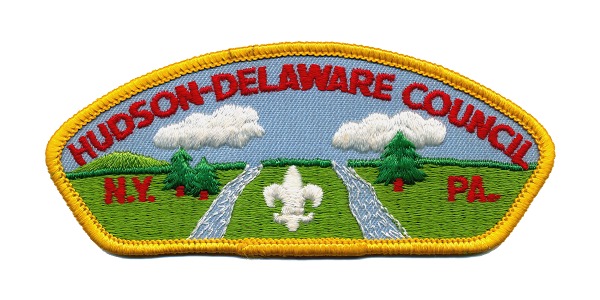
1972 marked the first year of modern Council Shoulder Patches as well as the 50th Anniversary of the Hudson-Delaware Council. Both made use of the same image – two rivers running through a green field with one side marked N.Y. with two trees and a mountain, the other side marked PA. with one tree, and a white fleur-de-lis in the middle section, all under two white clouds. With two counties/districts in NY and one in PA, the symbolism seems pretty obvious, even if the geography doesn’t work (the two NY counties should be between the rivers). Sometimes it’s best not to think about these things.
Four variations of this patch are known to exist: Cloth Back (CB) and Plastic Back (PB), each with both Left Twill (TL) and Right Twill (TR). The only place I’ve seen all of these variations (as well as some of the variations of the revised design) is on Kirk Doan’s web site. Kirk authored a short-lived CSP guide, “The Blue Book: A Guide to Council Shoulder Patch Varieties and Values,” last published in 1988 (Introduction). The first edition of this book, published in 1987, lists the same variations shown on the web site.
Interestingly, the twill colors are also different consistent with the direction – left is darker than right in both cases.
Hudson-Delaware Council R3 – 50th Anniversary Year (1972)
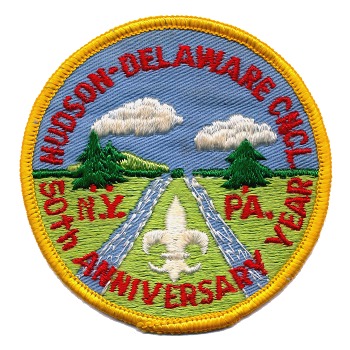
The same design is also featured on a 3″ round with about the same level of detail and the same colors, despite being listed as having a dark yellow border and blue twill vs. the CSP’s yellow border and light blue twill (though slightly darker than the right twill in the CSP). Judge for yourself, I guess.
Hudson-Delaware Council R4 – Two Rivers Jacket Patch (1972)
This design was also used on a jacket patch with more detail than the other versions. I’ve never seen a color photograph of this one, so I don’t know how the details compare to the above.
Hudson-Delaware Council Belt Buckle – Two Rivers, Three Trees Logo (1970s)
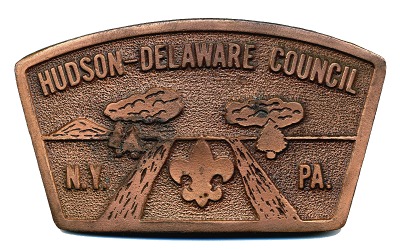
There’s even a belt buckle with this logo. I found it in a random lot on eBay and know nothing about it except it was apparently manufactured by Hit Line USA.
Beech Mountain Scout Camp Neckerchief – Two Rivers, Three Trees Logo (1976?)
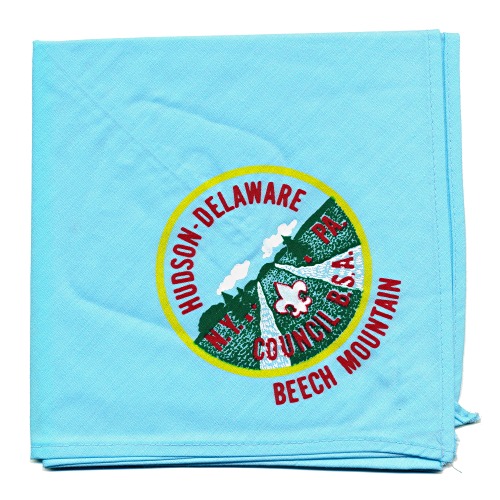
Beech Mountain Scout Camp makes an appearance here with a light blue neckerchief featuring a silk screened approximation of the round version of this logo. The neckerchief is undated, but my father had it stored with the 1976 Beech Mountain pocket patch (the outline of which is still visible embedded in the fabric), so I’m guessing that’s when it was from. This version has more detail in the skyline than any other version except the jacket patch, showing several lower peaks across the horizon instead of just the one mountain on the left.
There is also a Beech Mountain Scout Camp mug with a colored sketch of the CSP design on it. Mugs are outside the scope of what I deal with, so it only gets a mention.
Hudson-Delaware Council 03 – 1981 National Jamboree (1981)
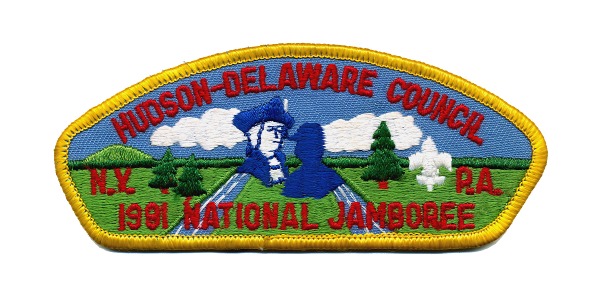
Finishing off the “two rivers, three trees” era is the Hudson-Delaware Council’s first National Jamboree patch. It features the same basic design as the regular issue CSP with all-new embroidery and a slightly different twill and has the 1981 National Jamboree logo placed in that tempting blank space in the middle. In addition to the “1981 NATIONAL JAMBOREE” text on the bottom, Pennsylvania gets a second period in its abbreviation to match the New York side. Don’t get used to it.
This patch is the first forgotten patch in Hudson-Delaware history (but not the last). The 1984 Second Edition to the update of Arapaho I is the earliest documented appearance of this patch in any guide. The CSI Guide never mentions it because it doesn’t include JSPs. But “BSA National Jamboree Shoulder Insignia: A History in Color” omits it 17 years later. And Councilstrip.com forgot this one and the 1985 patch as well. The 2012 edition of The Council Guide doesn’t list it either. It doesn’t show up again until the redlined post-2012 update to the online version of The Council Guide, without an official designation. Their placement of it behind the next three patches (listed in the CSI Guide as being released in 1981) is suspect because of the redesign in those that isn’t seen in this patch. I’m putting it here to keep the three tree designs together. And, considering they got it wrong with 1993, it seems clear that they were just guessing.
Hudson-Delaware Council Part 3: Two Rivers, Four Trees
Hudson-Delaware Council 04 (TA2/T3) – SME (Red Border) (1981)
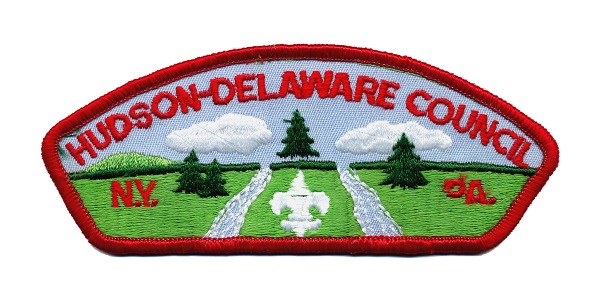
Hudson-Delaware Council 05 (TA3/T4) – SME (Silver Mylar Border) (1981)
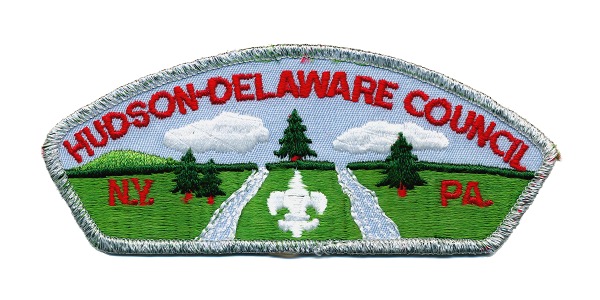
Hudson-Delaware Council 06 (TA4/T5) – SME (Gold Mylar Border) (1981)
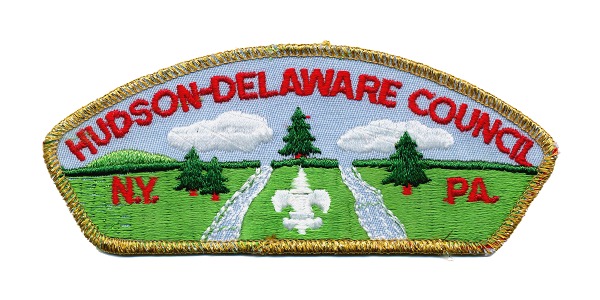
These three patches are listed in the CSI Guide as “Sustaining Membership Enrollment” (SME), which sounds like the ’70s/’80s equivalent of today’s “Friends of Scouting” (FoS). The timing here is interesting – not only was 1981 the 50th anniversary of the Orange-Sullivan Council (a date I haven’t seen referenced in any memorabilia until 2016), but this was at the time of the sale of Beech Mountain Scout Camp, when the council would have been flush with cash. So why the limited edition patch sale? There has to be a story here.
While they share the same basic design as the previous (and following) regular-issue CSPs, the embroidery is different. I would even call it sloppy. Red and green thread can be seen peeking out from the borders, almost like they were from the patches having been sewed onto something. Only the thread is identical to the thread used elsewhere in the patch and it is both under the border and behind the plastic backing. The clouds and FDLs look flat and incomplete and the light blue twill is lighter than on any other issue. And the trees are narrower. (The red border version shown here is a thread break, so don’t read anything into the unfinished P or missing tree trunks.)
Prior to owning these, the only place I’d ever seen them in person was in the Hudson-Delaware Council history display hanging on the wall in the main lodge at Camp Ranachqua. After two council mergers, several changes in management of the camp, a complete renovation of the building, and the closure of Ranachqua last fall, I have no idea where that display is now. It folds up for easy travel, so it might have walked away…
Hudson-Delaware Council 07 (T5/T6) – Regular Issue (TL) (1981-1995)
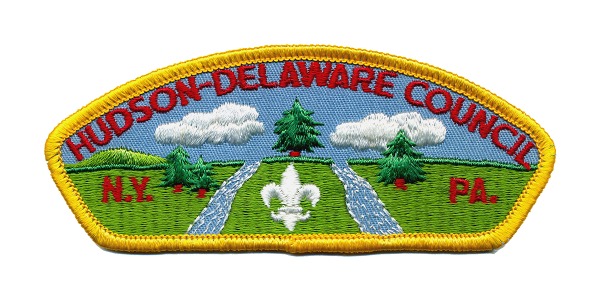
Hudson-Delaware Council 07 (T5/T6) – Regular Issue (TR) (1981-1995)
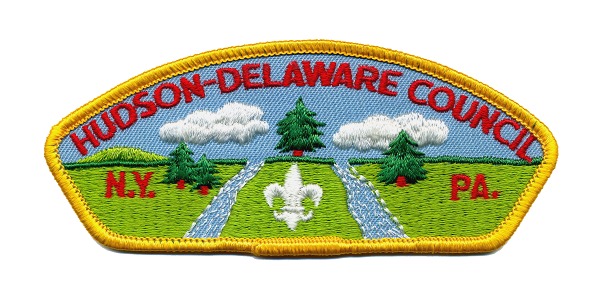
Hudson-Delaware Council 07 (T5/T6) – Regular Issue (TRS) (1981-1995)
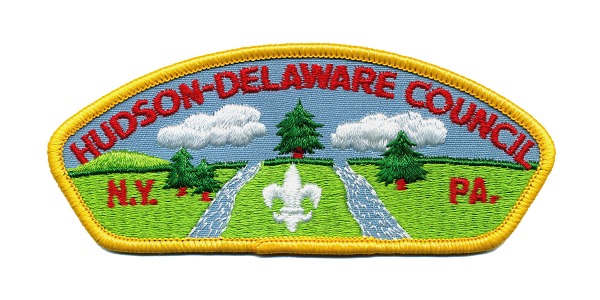
After the three border color variants above, we have the regular issue version of the new Hudson-Delaware Council CSP, updated and modernized for the 1980s. With the addition of a tree in the blank space in the middle. Other than that one change, the embroidery is nearly identical to the previous version. Out with the old, in with the same old thing plus a tree. Three twill variations are known: the left twill is slightly lighter and smoother than the previous left twill, the right twill is slightly rougher than the previous right twill, and a smoother, almost nondirectional, right twill rounds out the trio. I generally try to avoid calling out smooth/rough twill because I don’t have an objective standard to reference (Has anyone made the equivalent of a perforation gauge for twill?), but the difference here is clear.
Why the fourth tree? If the trees represented districts, then this could still work. After all, the Nava-Len District used to be two separate districts, the Navasink and Lenape Districts, until sometime in the early ’60s (based on memorabilia, they were separate at the start of the Hudson-Delaware Council and merged by 1965). So the two trees together on the left could represent the Nava-Len District. And maybe that makes the mountain Beech Mountain? So the new tree would be the Hudson River District, which somehow wasn’t in the original design despite being the oldest part of the council? Or did one of the trees on the left get retconned from representing the Hudson River District to being part of the Nava-Len District? Either way, it should be clear by now that the rivers are notional and are not intended to be geographically accurate.
The 1997 edition (Volume One) of “The Boy Scout Council Shoulder Patch Guide: A Tour of Councils Through Their Patches” by Steven and Elisa Delman seems to confirm some of this, maybe. They list the issue date of this patch as the completely impossible 1990 and state:
On this patch, the rivers represent the Hudson in New York, and the Delaware in Pennsylvania. The trees stand for the number of districts in the Council. The previous patch had four trees. The fourth district dissolved in 1989, thus the new patch has only three trees.
The patch shown an inch and a half directly above this text had, in fact, four trees. Grammatical and geographical errors aside, it’s hard to sort out exactly where they went wrong here because this is wrong in so many ways. In any case, as someone who joined the council in 1988, I can confirm that this patch was issued long before 1990 and no three-tree version was issued afterward. It seems clear that this book is not a reliable source, at least as far as this patch is concerned.
This would be the longest-lived regular issue Hudson-Delaware Council CSP, remaining in regular use to the end of the council and beyond. And, as boring as it is, it was still better than the next regular issue CSP.
Hudson-Delaware Council 08 (CG S7) – 1985 National Jamboree (1985)
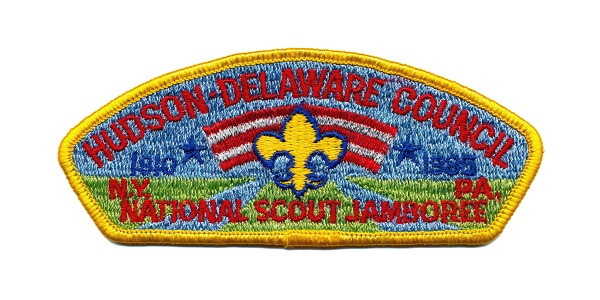
As with the 1981 patch, the 1985 National Jamboree patch got a redesign incorporating part of the jamboree logo in the middle. Unlike last time though, this one was fully embroidered, a Hudson-Delaware Council first. It also featured a plastic back, making it the only Hudson-Delaware Council shoulder patch with both of these features.
As for the trees, well, there aren’t any. The field was clear-cut to make room for the jamboree logo. No mountains or clouds either. At least that makes this one easier to interpret.
Hudson-Delaware Council Pin – 1985 National Jamboree (1985)
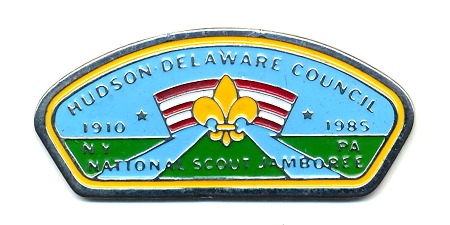
In another first, this patch had a corresponding pin. And, like the first Skanondo lodge flap pin, it featured a screw back rather than the usual clasp-type back. Unlike that pin though, nothing is misspelled here.
Hudson-Delaware Council Neckerchief Slide – 1985 Diamond Jubilee (1985)
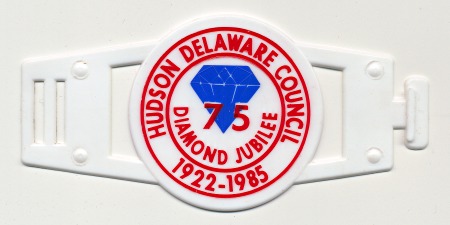
A flat plastic wrap-around neckerchief slide (of the kind apparently only used from the mid-’70s to the mid-’80s) also exists. I do not know if this was an official part of the uniform or an optional piece of memorabilia. Or if it was even related to the jamboree at all.
Hudson-Delaware Council Pin – Liberty Celebration (1986)
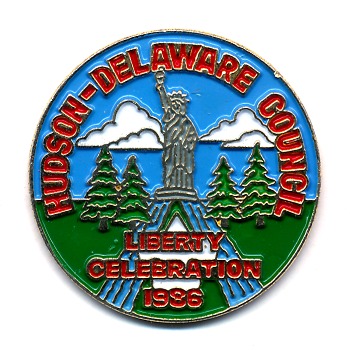
If you were worried about the trees, I have good news for you – they grew back in a year! The mountain, not so much (RIP Beech Mountain Scout Camp). For the 1986 Liberty Celebration (whatever that was), the logo was redesigned again to put two trees on either side of the two rivers with the Statue of Liberty in the middle. And now there are four clouds. I hope none of this is supposed to have any sort of deeper meaning because I’ve got nothing. And I don’t know if there was a corresponding patch or other memorabilia from this event. I don’t even know how I ended up with this pin.
Hudson-Delaware Council – 65 Years 1922-1987 (1987)
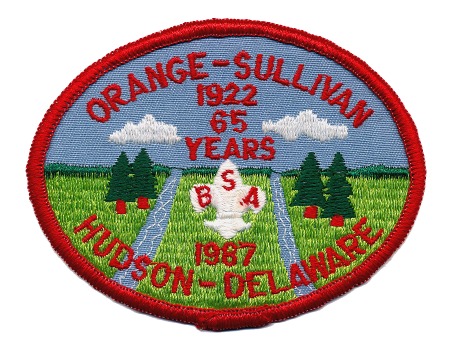
The trees would be similarly paired on opposite sides of the two rivers in the 1987 patch celebrating the council’s 65th anniversary. 65 is an odd number to celebrate, but the council wouldn’t make it to 75, so whatever. Not that facts would stop it from celebrating its 75th anniversary anyway… This patch is done in a style resembling the 50th anniversary patch only in an oval with a red border. And this patch specifically calls out the Orange-Sullivan Council, which was not, in fact, formed in 1922. Anniversaries, and history in general, really aren’t this council’s strong suit…
Hudson-Delaware Council 09 (NJ1989/S8) – 1989 National Jamboree (1989)
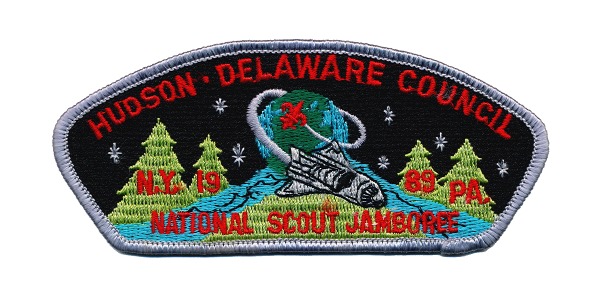
For its next Jamboree, the Hudson-Delaware Council switched things up by replacing the yellow border and light blue background with a gray border and black background. The trees were back, but the jamboree logo in the middle makes it look like they’re in space sucking the water out of the Earth’s oceans. It’s a bold new look that still retains the key elements of the base design.
Hudson-Delaware Council Pin – 1989 National Jamboree (1989)
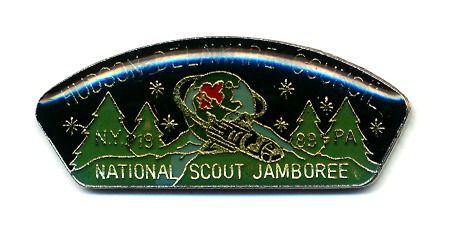
This design also had a corresponding pin, though this time in a smaller size with an annoying plastic coating that yellows over time and doesn’t scan well.
Hudson-Delaware Council Neckerchief – 1989 National Jamboree (1989)
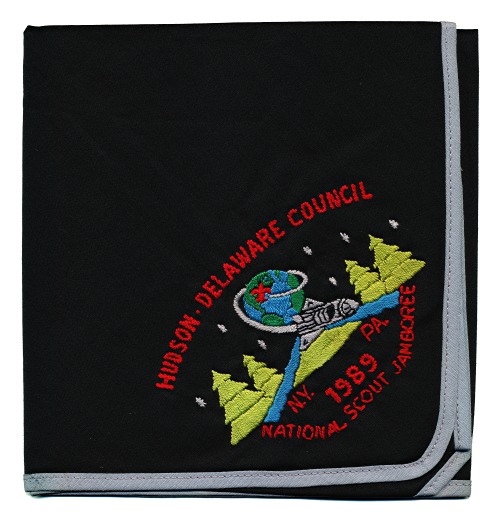
And then there’s this neckerchief I found in the TMR Museum’s trading post. I don’t know if this was an official issue or a custom job, but it sure looks sharp.
Hudson-Delaware Council 10 (TA6/T9) – Camp Ranachqua Staff (1990)
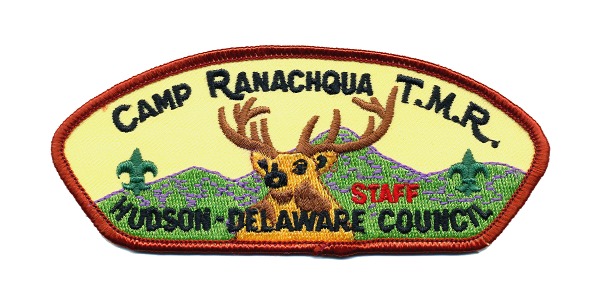
Hudson-Delaware Council 11 (TA7/T10) – Camp Ranachqua Staff (1991)
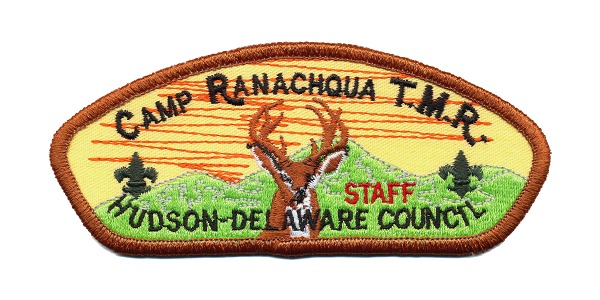
Camp Ranachqua had been operated by the Hudson-Delaware Council for nearly a decade before issuing any memorabilia marked “STAFF.” It’s possible that the white-bordered rectangular pocket patch issued in the ’80s was used as a staff patch, though I don’t have a source for that. These two council strips, with pictures available on Councilstrip.com or in the Ten Mile River Scout Museum‘s “A Guide to Memorabilia of the Ten Mile River Scout Camps,” were issued in 1990 and 1991, respectively, according to the CSI Guide, which also lists production runs of 100 patches for each. I can’t independently confirm this, but I do know that one or both of them were still in use in 1992 along with a green-bordered rectangular pocket patch similar to the white-bordered patch from the ’80s. These two council strips would be the only marked Ranachqua staff patches until 1993, when a staff variant of that year’s regular camp patch was produced. Staff versions would be made of each of the camp’s annual patches through 1997, the second year it was operated by the Hudson Valley Council.
Hudson-Delaware Council Part 4: Sunrise Over the Hudson
1991 Cluster Camporee – Jacket Patch (1991)
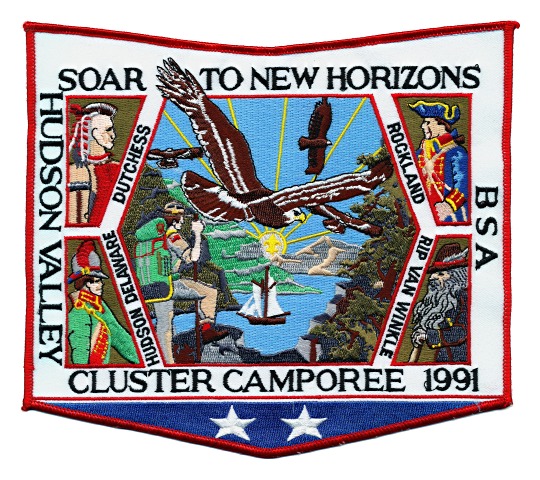
1991 marked the dawn of a new era, symbolized by this artwork of the sun rising over the Hudson River. This image would remain in use for nearly 30 years, including the entire 25-year run of the Hudson Valley Council. That’s fitting because of it’s origin – as a symbol representing four of the Hudson Valley’s councils in 1991. Three of those would go on to form the Hudson Valley Council, to nobody’s surprise.
It was a thinly-veiled secret that 1991’s Hudson Valley Cluster Camporee, held at Orange County Park that October, was a dry run of the logistics required to manage a combined council event in advance of an inevitable merger. The Hudson-Delaware Council’s finances were known to be a mess (I don’t remember if this was before or after the massive embezzlement scandal) and things didn’t seem much better for its neighbors. It was only a question of when, not if, some or all of these councils would merge. Within half a decade, three of the four would merge together, leaving just the Rip Van Winkle Council independent as it remains to this day.
This jacket patch offers the most detailed look at the earliest use of this image in memorabilia that I am aware of. Additional memorabilia, including a pocket patch (issued to all attendees), pin, mug, hat (plain snapback with the pocket patch sewn on the front, as was the style at the time), etc. was also produced and was available for sale at the trading post I somehow never visited. At least you can still get the jacket patches for about the same amount they cost in 1991. Maybe producing more memorabilia than they could sell was one of the problems that got them into this mess…
This would be the last time the entire Hudson-Delaware Council assembled for an event until May of 1994, a year and a half before the end.
Hudson-Delaware Council 12 (NJ1993/S12) – 1993 National Jamboree (1993)
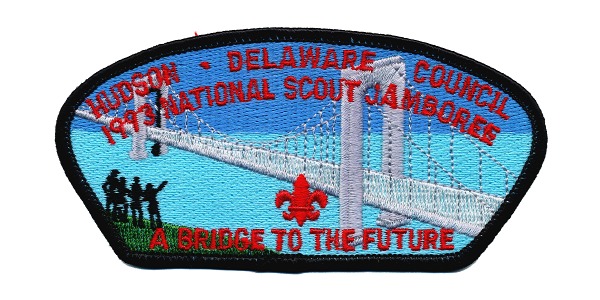
Finally, in 1993, it would be my turn to attend a National Jamboree. And I would get an all-new council strip to call my own. Jamboree strips were gaining popularity throughout the ’80s, so there were high hopes for something great that would be in high demand at the various patch trading venues (which is basically everywhere at the jamboree). The theme was “A Bridge to the Future,” which most councils would probably take literally and represent with a bridge of some sort. The Hudson-Delaware Council had lots of interesting bridges in and around its territory, including two over the Hudson. Personally, I’m a bit partial to the Moodna Viaduct. But if you want to celebrate the history of the entire Hudson-Delaware Council, there’s only one choice – the Roebling Bridge.
Built to carry the Delaware and Hudson Canal over the Delaware River between Pike and Sullivan Counties, the Roebling Bridge (aka Roebling’s Delaware Aqueduct) is the oldest wire suspension bridge still in use in the US. In its original form, it carried coal from Pennsylvania destined for New York City, helping to literally fuel its expansion into the city it is today. That sure sounds like a Bridge to the Future to me…
But that’s not what we got. Instead, we got an approximation of the George Washington Bridge on a two-tone blue background with the silhouetted figures from the jamboree logo pointing at it from a tiny strip of green. There was nothing of the Hudson-Delaware Council in this patch. And it was going to be an uphill battle trading this thing for anything worthwhile at the jamboree.
Hudson-Delaware Council Pin – 1993 National Jamboree (1993)
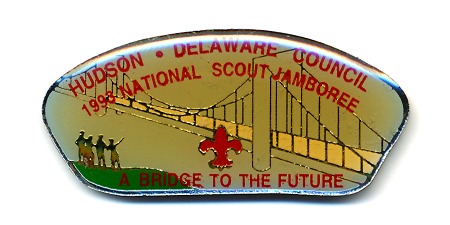
As expected, there was also a pin version, which manages to look even worse than the patch. Trading these was next to impossible and I still have a bag full of them.
Rounding out the memorabilia are the official Class B uniform components for the council, a plain gray snapback hat with the black-bordered patch sewn on the front and a gray t-shirt with the patch design printed on it in red. Stylish, we were not. Extras were available for sale with at least the hats still available at the end of the jamboree. I bought one to have for my collection because my issued hat was full of sweat and pins. No photos here because, come on, it’s a gray hat with the patch on it. Use your imagination.
Hudson-Delaware Council 13 – 1993 National Jamboree Troop 1015 (1993)
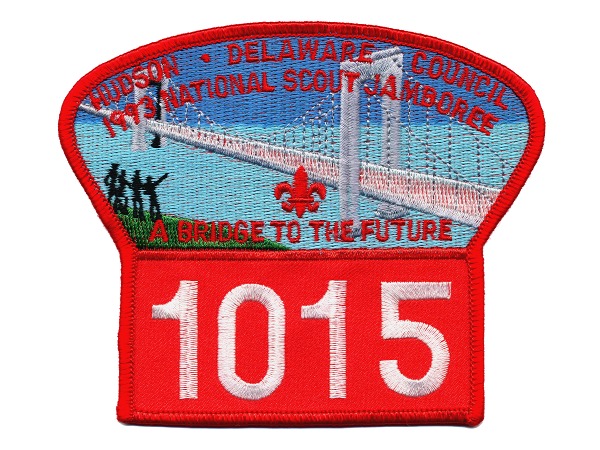
Luckily, the black-bordered patch was not what we wore on our Class A uniforms. Instead, we had this snazzy red-bordered variant with the troop number (1015 in my case) attached in a form nearly identical to the generic troop number patches of the time. At a glance, you couldn’t even tell this was a single patch. And the bare twill in the troop number section would make this a T designation while the trader is an S. Or at least it would be if any CSP reference ever made had cataloged this patch and/or its 1116 counterpart. But none of them did, making these more forgotten Hudson-Delaware Council patches. Until now.
Also, can we discuss how silly it is to classify a patch based on whether any bare twill is visible? Why is that even a thing? And why is it only a thing for council strips and lodge flaps? Collectors obsess over the silliest things.
Hudson-Delaware Council 14 – 1993 National Jamboree Troop 1116 (1993)
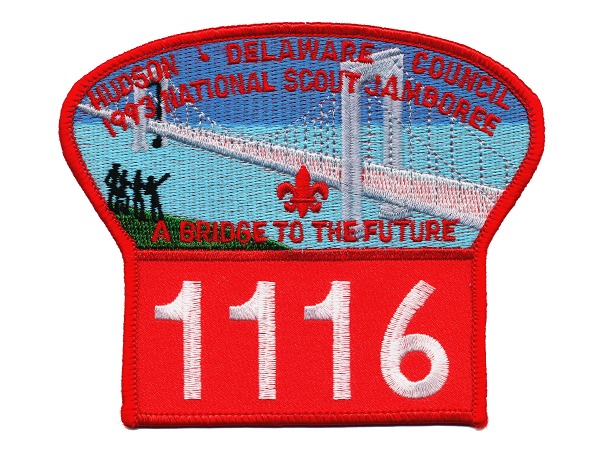
The Hudson-Delaware Council sent two troops to the 1993 National Jamboree and 1116 was the second. I don’t know how they determined who would be in which troop. Each troop consisted of four 8-Scout patrols, four junior leaders, and four adult leaders, making 40 total per troop. Each person was issued two of their troop’s shoulder patches for a total of 80 issued of each patch, all of which should have been sewn onto a uniform shirt and possibly (hopefully) laundered at least once. It is likely that a few extras might have been ordered as spares, and could therefore be in unused condition, but no extras were advertised for sale to the troop members (and EVERYTHING was available for sale – the council needed money). Even with the possibility of extras, these would rank as some of the rarest Hudson-Delaware issues, up there with the Camp Ranachqua Staff patches and possibly the SME patches. But the rarest is still to come.
Hudson-Delaware Council 13.5 – 1993 National Jamboree Troop 1016 (1993)
So, um, apparently I wasn’t imagining it when I saw a 1016 version of the 1993 jamboree contingent patch. This was back before I started working on this post, so I didn’t bother making note of it even though it seemed off. Sure, I knew that our two troops were 1015 and 1116, but maybe I was remembering things wrong. And then by the time I started on this, all I found were 1116s. So I once again doubted my memory and relegated the 1016 patch to the realm of the imagination.
And then the JSP guide included the 1016 and 1116 versions (but not 1015) in its otherwise comprehensive coverage of jamboree issues. I sent along a correction to help make it just a little bit more perfect and received a response containing a picture of my new nemesis – the 1016 patch. So it does exist. And just when I had finally finished off the complete Hudson-Delaware Council set. It’s always something…
I’m not quite sure what to do with this thing. It wasn’t an official issue. Or was it? Without knowing the full story, it isn’t possible to properly classify it. Was it intended to be 1015? If that’s the case, then it definitely wasn’t issued to the troop because I never got one. If it was supposed to be 1116, did it get issued and replaced? Or was it just stashed away when the corrected versions arrived? And if that’s the case, was the patch an error from the start or did the troop number change at some point?
Or was Troop 1116 really supposed to be Troop 1016 all along? I always thought it was strange that we had two troops with consecutive numbers in adjacent subcamps. Maybe there was a simple explanation for everything – what if our troops actually were both in Subcamp 10? Looking at the jamboree map, Subcamp 11 would have been across the street, not at the bottom of the hill and around the corner, which is where I remember 1116’s site being – that would have still been in Subcamp 10. If the 1116 patch was the error, maybe they just didn’t get the corrected versions in time to issue them for the jamboree (unlike what happened the next time). So how did the 1016 patches get out?
Or maybe I’m still imagining things and the other troop always was 1016. In any case, I’m calling this one number 13.5 because I don’t know what do do with it. Were you in Troop 1116/1016/whatever? Leave a comment and help me figure out this mess.
Hudson-Delaware Council Neckerchief – 1993 National Jamboree (1993)
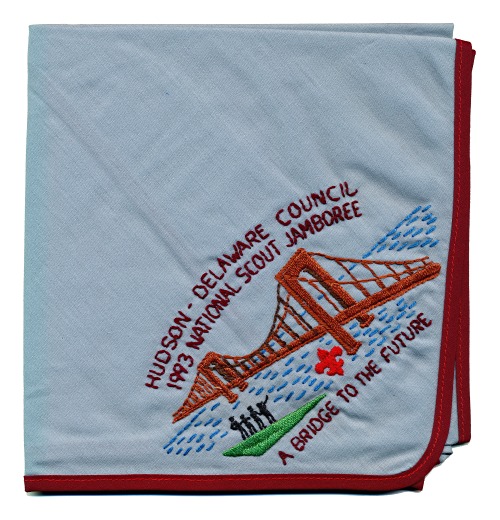
Apparently a neckerchief also exists. I saw this for the first time 30 years later, so it’s a safe bet that it wasn’t part of the uniform (it certainly wasn’t part of mine) and wasn’t advertised for sale to contingent members. This one came new in the bag with a Chief Neckerchief slip of paper, though it (as with the 1989 version) was clearly a Chief Neckerchief design. I have even more questions now. And on top of that, they almost made this design look good. We totally should have worn these to the jamboree…
Hudson-Delaware Council 15 (SA8/S11) – Fundraiser (1993)
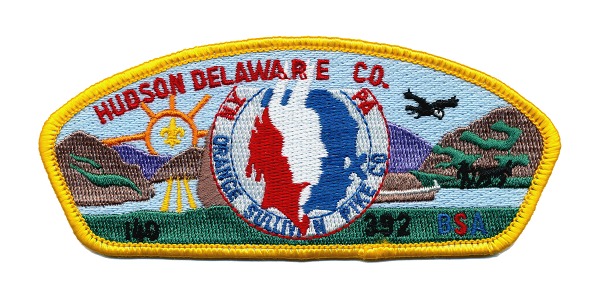
Oh, what could have been… This council strip is exactly what the Hudson-Delaware Council needed after more than two decades with a design that was outdated almost immediately. The “HUDSON DELAWARE CO.” name format from the second Orange-Sullivan Council strip, the overlapping heads logo from the early Hudson-Delaware Council, the sunrise over the Hudson scene from the ’90s, and the D&H Canal scene with bald eagle overhead… So much thought went into every last detail, as described on the accompanying certificate of authenticity:
The certificate is dated November 30, 1993, putting this after the disappointingly generic 1993 National Jamboree patches. If only this much thought had gone into that patch… But that was not to be and this patch would never grace the shoulders of Scouts in the Hudson-Delaware Council. Most of us had no idea it even existed until long after the Hudson-Delaware Council was no more. Instead, our next and last general issue council strip was…
Hudson-Delaware Council 16 (T9/T13) – Regular Issue (1994)
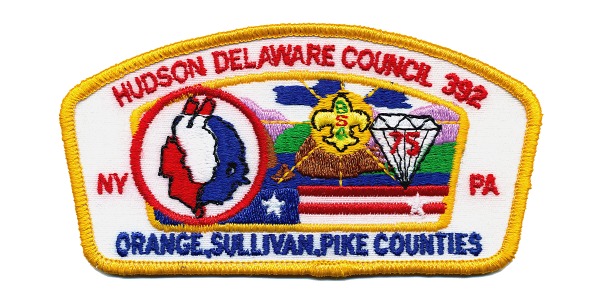
This.
I don’t know where to even begin describing this Homermobile of confusing and poorly-executed ideas mashed together into a disappointing misshapen patch. The missing hyphen seems less like an homage to the third Orange-Sullivan strip and more just a straight-up mistake. The previous strip‘s use of the council number seemed odd but fitting considering the historical references. Here it just seems out of place. The massive white twill area around the cramped graphic space seems to serve no purpose except to sop up dye from the bright red and blue thread. The overlapping heads logo is barely recognizable and the sun over the Hudson is now in front of the mountains, apparently about to engulf us all in fiery death, having already turned the sky white and the clouds blue in the approaching armageddon. There’s part of a flag at the bottom for some reason, showing only four stripes and two stars, one of which is over the stripes. And then there’s the 75th anniversary diamond jubilee logo.
Why the heck is there a 75th anniversary logo on a Hudson-Delaware Council patch issued in 1994? What happened in 1919, three years before Council 392 existed in any form, that this patch felt was worth commemorating? There was a certain council in the area that was formed in 1919, merged with a neighboring county council in the 1930s, and then changed its name in the 1950s. If you were paying attention to last year’s Skanondo anniversary mysteries, you might see where I’m going here. That’s right, it’s our neighbor to the north, the Rip Van Winkle Council, formerly the Ulster-Greene Council, formerly the Ulster County Council (established 1919). Coincidence or epic screw-up? You decide.
We were issued this patch in 1994 and were told that we could wear it in place of the two rivers, four trees patch. I declined. And I thought less of anyone who chose to wear it.
Hudson-Delaware Council 17 (TA10/T14) – Fundraiser (1994)
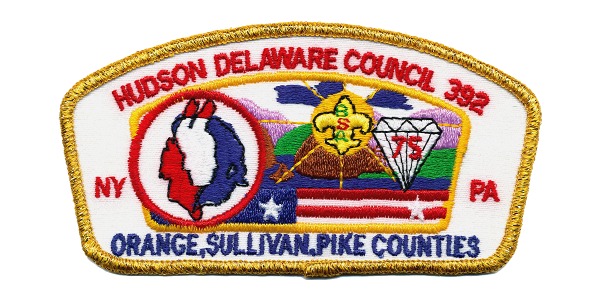
A gold mylar border version was also released as a fundraiser, limited to 50 copies. This is one of them. And that’s all I know about this. The Hudson-Delaware Council’s shoulder insignia history ends here.
Hudson Valley Council
Hudson Valley Council 01 (S1/S1) – Defective (1996)
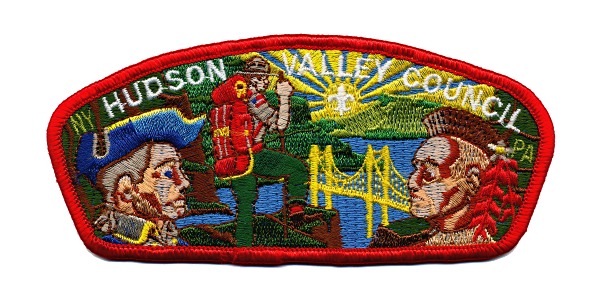
Just kidding, it never truly ends. For its first council strip, the Hudson Valley Council went back to the source and brought together the central image from the 1991 Cluster Camporee design and heads of the figures representing Rockland and Dutchess Counties on a fully-embroidered patch. With the name spelled correctly, even. Except the original finished product was such a horrid mess that they needed to redesign it before it was fit to be seen by human eyes. Maybe using Inside-Out Boy as the character model wasn’t the best idea…
Hudson Valley Council 02 (SA2/S2) – Fundraiser (1996)
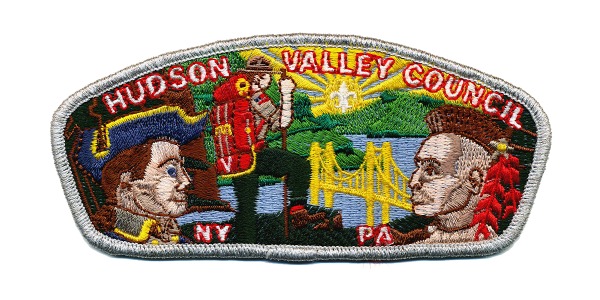
After a quick redesign, they… Issued a silver-bordered fundraiser version of the updated design. These redesigns won’t pay for themselves. Or will they?
Hudson Valley Council 03 (S3/S3) – Regular Issue (1996)
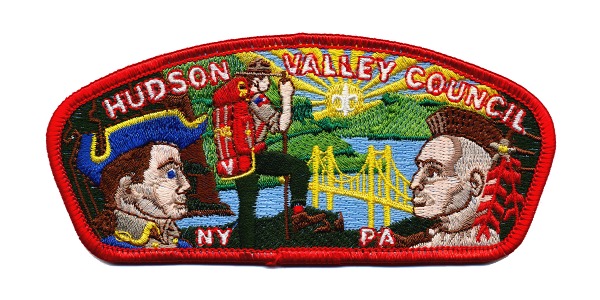
Finally, the third version was the first to actually be issued to Scouts.
The 1999 edition (Volume Three) of “The Boy Scout Council Shoulder Patch Guide: A Tour of Councils Through Their Patches” credits Dave Whitten with the design, though it isn’t clear whether the credit is for the original artwork, this specific patch design, or both. He would receive a similar credit in a later volume for the design of the next (and last) Hudson Valley Council regular issue CSP.
It took nearly a quarter of a century and the loss of their council, but the Scouts of the Hudson-Delaware Council finally had a fully-embroidered regular issue council strip. For me, it was too little, too late. Though officially in the Hudson Valley Council when my Eagle board (including the previously mentioned Stan Ferguson) signed off on me earning BSA’s highest rank and when I received said rank at my court of honor, I wore a Hudson-Delaware Council patch on my shoulder for both occasions. And my Eagle Scout card is embossed with the number 392. But maybe this was a sign that things were moving in the right direction as the new council prepared for its first National Jamboree.
Hudson Valley Council 04 (SA4/S4) – Fundraiser (1996)
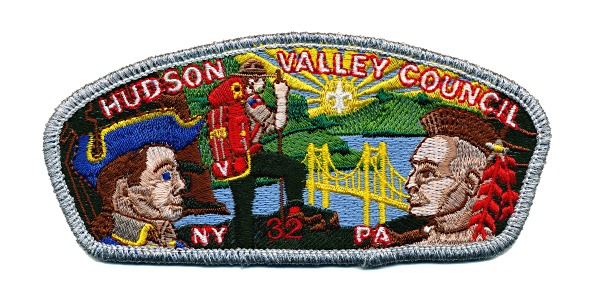
Before that though, how about another fundraiser version? For the second act, they kept the silver mylar border and added serial numbering. As with the 1993 Hudson-Delaware Council fundraiser, these were limited to 500 copies and came with a certificate of authenticity, this one dated September 8, 1996:
Well, that explains what went wrong with the first attempt – they left out the “V”alues! No designer is credited here, so the previous question still stands.
Hudson Valley Council 05 (NJ1997-ERR-RED/S5) – 1997 National Jamboree “NUDSON” (1997)
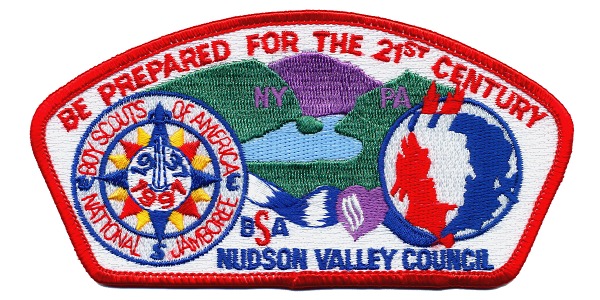
With its opening CSP debacle behind it, the Nudson Valley Council set its sights on the 1997 National Jamboree. Wait a second… Both the red border trader patches and the gold mylar border contingent patches were initially produced with a hilariously wrong council name, as per tradition. They were corrected in time for the event, robbing history of some quality comedy. But do you see the size of this thing? That must have been some sight on a shoulder.
The size did at least offer sufficient space to render recognizable details, so I can’t joke too much. It could be worse…
Hudson Valley Council 09 (T5/T9) – Regular Issue (1999-2020)
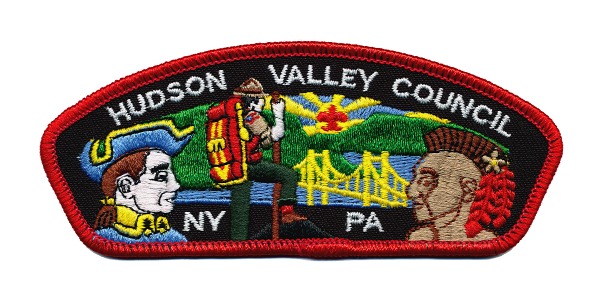
Case in point… The fully-embroidered Hudson Valley Council CSP was short lived. After a three-year run, it was replaced with this simplified version with a bare twill border around a tiny version of the original scene. There isn’t even enough room for the hiker to get into the picture. The 2002 edition (Volume Five) of “The Boy Scout Council Shoulder Patch Guide: A Tour of Councils Through Their Patches” again credits Dave Whitten with the design and lists the issue date as 1999. Hopefully they got at least that much right for a patch issued by their home council while they were working on these books…
Aside from an apparent error version with a white brim on the Rockland County figure’s hat, this would serve as the Hudson Valley Council’s regular issue CSP for more than two decades, right up to its merger with the Westchester-Putnam Council at the start of 2021. A gold mylar border version dated 1996-2020 was released to commemorate the Hudson Valley Council’s 25-year run.
Hudson Valley Council 10 (SA6/S10) – Fundraiser “Caretakers of Character” (1999)
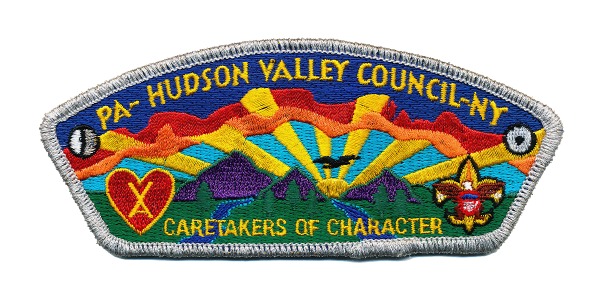
Hudson Valley Council 11 (SA7/S11) – Fundraiser “Illustrators of Integrity” (1999)
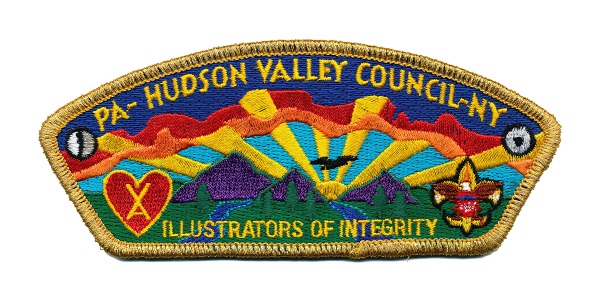
But we’re not done quite yet. In 1999, the Hudson Valley Council released two fundraiser strips, “Caretakers of Character” and “Illustrators of Integrity.” The June 1999 issue of “The American Scouting Traders Association Report” lists the price of these as $10 each. At first glance, these appear to just be colorful patches with a generic landscape. But look closer at the bottom and you’ll see a familiar pair of rivers running through a green field. This time, there are six trees, one on the left, two on the right, and three in the middle. I’m not even going to guess at the symbolism. Sadly, I don’t know of any other uses of this imagery on Hudson Valley Council patches.
Hudson Valley Council 12 (NJ2001/S12) – 2001 National Jamboree (2001)
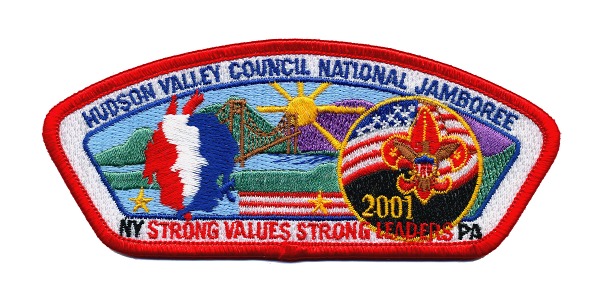
Next up, the sun is back in force! Omitted from the 1997 National Jamboree patch, it was back for the 2001 National Jamboree on a patch that takes way too many design cues from the 1994 Hudson-Delaware Council patch. The overlapping heads logo is back one last time, shrunken down but still somewhat recognizable. The flag segment with star over the stripes makes a return for some reason. And the sun once more appears to be in front of the mountains, now with a rotated Bear Mountain Bridge directing traffic into the path of the doomsday star.
Hudson Valley Council Fundraiser – Hudson-Delaware Council (2016)
A year after Nacha Nimat Lodge issued a patch set featuring historical reproductions of its predecessors’ patches, the Hudson Valley Council followed suit with this 6-patch fundraiser set, limited to 100 copies according to PatchScan, which lists the issue date as 2019. Available for just a $500 donation, this set included reproductions of early patches from the three councils that merged to form the Hudson Valley Council. For the Hudson-Delaware Council, they went with the 1981 design and ghosted the date “1931” in the cloud on the left. That’s interesting given the timing of the original patch’s release and the fact that the Hudson-Delaware Council always used the 1922 date. I’d really like to know their reasoning for choosing this over the 1972 patch and 1922 date. One more mystery to add to the pile…
Greater Hudson Valley Council
Greater Hudson Valley Council 01? – Regular Issue (2021)
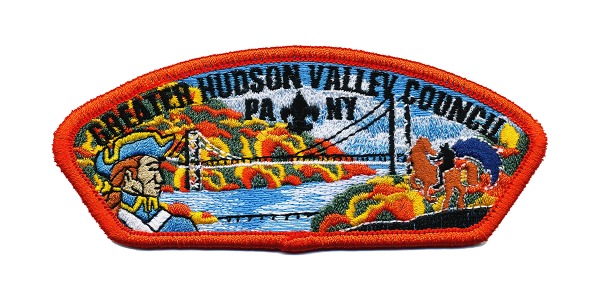
As of the start of 2021, the Hudson Valley Council was no more. Replacing it was the Greater Hudson Valley Council, which soon issued its first council strip. Or maybe this is the second, there was also a limited edition gold border version numbered to 100. I’m not sure which one is officially the S1 or whether anyone is tracking this stuff anymore. This one has a lower product number, so I’m going with that. This patch shows the Bear Mountain Bridge spanning the Hudson River against the fall foliage with symbols representing the Hudson Valley Council (specifically the Rockland County Council part) and the Westchester-Putnam Council (specifically the Washington Irving Council part) on the wrong ends of the bridge. They got the council name right, for now.
It took nearly a quarter of a century and the loss of their council, but the Scouts of the Hudson Valley Council finally had a fully-embroidered regular issue council strip. Talk about deja vu…
And with that, we’ve come not to an end but to a new chapter in the history of the Hudson-Delaware Council. Once divided into four districts under the Orange-Sullivan Council, three districts under the Hudson-Delaware Council, and two districts under the Hudson Valley Council, the territory of the former Hudson-Delaware Council is now united as a single Hudson-Delaware District under the Greater Hudson Valley Council.
As for me, I’ll be going back to the beginning to explore the history of Beech Mountain Scout Camp in memorabilia and work out the details of the biggest mystery yet. Hopefully in less than a year this time.




















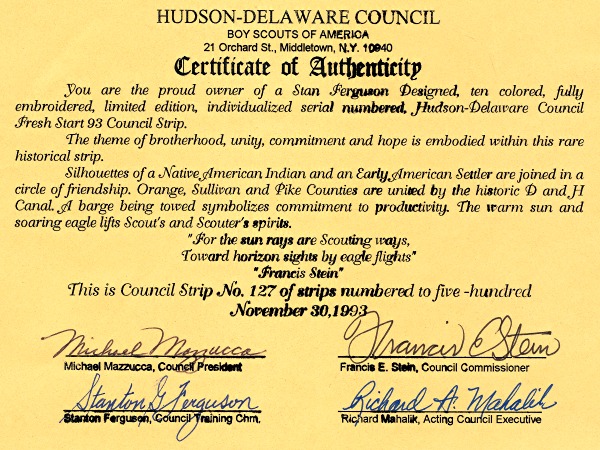
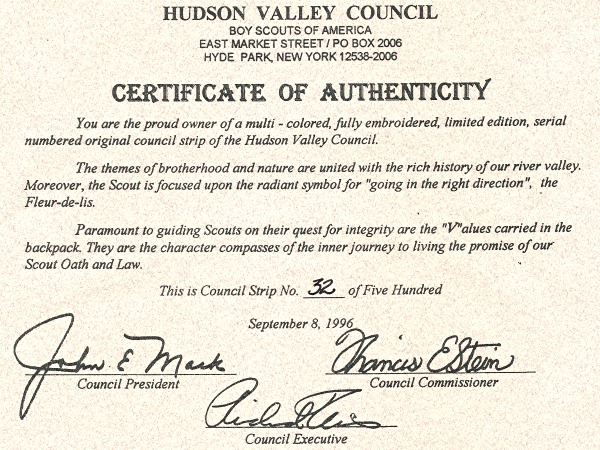
A couple of thoughts on your post here…
On the TMR staff patches. You’re correct that the square patch with the silver border was a staff patch in the 1980s, with one year’s patch actually containing the words staff. The CSPs were issued for the Post 392 uniforms worn by camp staff and I’d imagine the runs were low. I only received one of the 1990 patches and didn’t get a new one for 1991 as I “already had one”.
As for the JSPs in 1989 and 1993. First, the neckerchief in 1989 was indeed issued to all participants and was standard class A uniform wear for the jamboree. I was a participant in the 1989 jamboree and I still have the troop picture and we were all wearing the neckerchiefs. As for 1993, I don’t recall having that neckerchief at all and it’s not in my collection. My mom has, I believe, the troop picture somewhere that should help me recall what neckerchief we wore. My memory fails me in regards to the troop numbers. I know that there was some glitch somewhere along the line but I don’t remember what the glitch was. There are patches floating around with 1015, 1016, and 1116 but I’m not sure how the rogue patches were disbursed. I’m going to search through my dad’s collection to see what I can find. The choice of bridges is rather interesting. I always thought it was the Bear Mountain Bridge (which would only be half in our council but it’s old and majestic) but you’re right, it seems more a bad approximation of the GWB.
By the way, those pins with the plastic coatings were considered “premium” at the time and actually cost more that the previous pins. Who would’ve known that they would yellow over time. Mine have been mainly kept in storage, so they don’t look as bad as the ones in the picture.